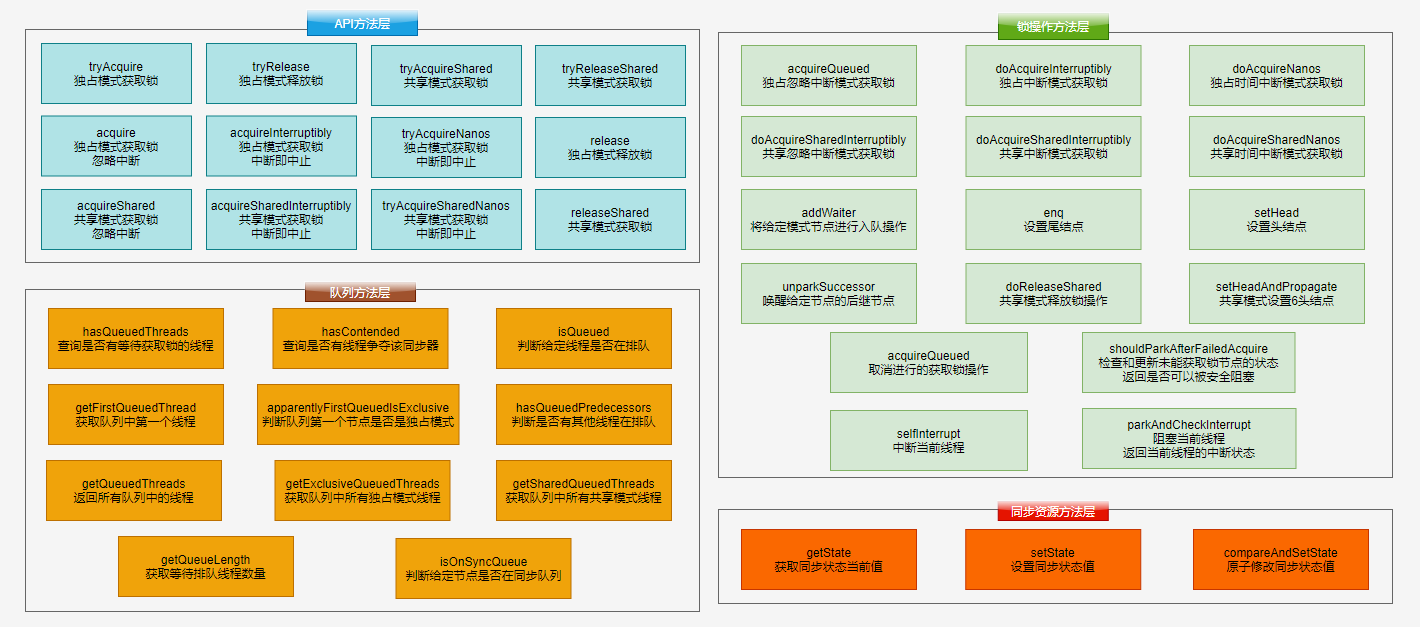概述:
AbstractQueuedSynchronizer,可以稱為抽象佇列同步器。
AQS有獨佔模式和共享模式兩種:
- 獨佔模式:
公平鎖:
非公平鎖:
- 共享模式:
資料結構:
- 基本屬性:
/**
* 同步等待佇列的頭結點
*/
private transient volatile Node head; /**
* 同步等待佇列的尾結點
*/
private transient volatile Node tail; /**
* 同步資源狀態
*/
private volatile int state;
- 內部類:
static final class Node {
/**
* 標記節點為共享模式
*/
static final Node SHARED = new Node();
/**
* 標記節點為獨佔模式
*/
static final Node EXCLUSIVE = null;
static final int CANCELLED = 1;
static final int SIGNAL = -1;
static final int CONDITION = -2;
static final int PROPAGATE = -3;
/**
* CANCELLED: 值為1,表示當前的執行緒被取消
* SIGNAL: 值為-1,表示當前節點的後繼節點包含的執行緒需要執行,也就是unpark;
* CONDITION: 值為-2,表示當前節點在等待condition,也就是在condition佇列中;
* PROPAGATE: 值為-3,表示當前場景下後續的acquireShared能夠得以執行;
* 0: 表示當前節點在sync佇列中,等待著獲取鎖。
* 表示當前節點的狀態值
*/
volatile int waitStatus;
/**
* 前置節點
*/
volatile Node prev;
/**
* 後繼節點
*/
volatile Node next;
/**
* 節點同步狀態的執行緒
*/
volatile Thread thread;
/**
* 儲存condition佇列中的後繼節點
*/
Node nextWaiter;
/**
* 是否為共享模式
*/
final boolean isShared() {
return nextWaiter == SHARED;
}
/**
* 獲取前驅結點
*/
final Node predecessor() throws NullPointerException {
Node p = prev;
if (p == null)
throw new NullPointerException();
else
return p;
}
Node() { // Used to establish initial head or SHARED marker
}
Node(Thread thread, Node mode) { // Used by addWaiter
this.nextWaiter = mode;
this.thread = thread;
}
Node(Thread thread, int waitStatus) { // Used by Condition
this.waitStatus = waitStatus;
this.thread = thread;
}
}
主要方法解析:

tryAcquire/tryAcquireShared(int arg)
獨佔/共享模式獲取鎖;由子類實現,僅僅獲取鎖,獲取鎖失敗時不進行阻塞排隊。
tryRelease/tryReleaseShared(int arg)
獨佔/共享模式釋放鎖;由子類實現,僅僅釋放鎖,釋放鎖成功不對後繼節點進行喚醒操作。
acquire/acquireShared(int arg)
獨佔/共享模式獲取鎖,如果執行緒被中斷喚醒,會返回執行緒中斷狀態,不會拋異常中止執行操作(忽略中斷)。
acquireInterruptibly/acquireSharedInterruptibly(int arg)
獨佔/共享模式獲取鎖,執行緒如果被中斷喚醒,則丟擲InterruptedException異常(中斷即中止)。
tryAcquireNanos/tryAcquireSharedNanos(int arg, long nanosTimeout)
獨佔/共享時間中斷模式獲取鎖,執行緒如果被中斷喚醒,則丟擲InterruptedException異常(中斷即中止);如果超出等待時間則返回加鎖失敗。
release/releaseShared(int arg)
獨佔/共享模式釋放鎖。
addWaiter(Node mode)
將給定模式節點進行入隊操作。
1 private Node addWaiter(Node mode) {
2 // 根據指定模式,新建一個當前節點的物件
3 Node node = new Node(Thread.currentThread(), mode);
4 // Try the fast path of enq; backup to full enq on failure
5 Node pred = tail;
6 if (pred != null) {
7 // 將當前節點的前置節點指向之前的尾結點
8 node.prev = pred;
9 // 將當前等待的節點設定為尾結點(原子操作)
10 if (compareAndSetTail(pred, node)) {
11 // 之前尾結點的後繼節點設定為當前等待的節點
12 pred.next = node;
13 return node;
14 }
15 }
16 enq(node);
17 return node;
18 }
enq(final Node node)
將節點設定為尾結點。注意這裡會進行自旋操作,確保節點設定成功。因為等待的執行緒需要被喚醒操作;如果操作失敗,當前節點沒有與其他節點沒有引用指向關係,一直就不會被喚醒(除非程式程式碼中斷執行緒)。
1 private Node enq(final Node node) {
2 for (;;) {
3 Node t = tail;
4 // 判斷尾結點是否為空,尾結點初始值是為空
5 if (t == null) { // Must initialize
6 // 尾結點為空,需要初始化
7 if (compareAndSetHead(new Node()))
8 tail = head;
9 } else {
10 // 設定當前節點設定為尾結點
11 node.prev = t;
12 if (compareAndSetTail(t, node)) {
13 t.next = node;
14 return t;
15 }
16 }
17 }
18 }
acquireQueued(final Node node, int arg)
已經在隊列當中的節點,準備阻塞獲取鎖。在阻塞前會判斷前置節點是否為頭結點,如果為頭結點;這時會嘗試獲取下鎖(因為這時頭結點有可能會釋放鎖)。
1 final boolean acquireQueued(final Node node, int arg) {
2 boolean failed = true;
3 try {
4 boolean interrupted = false;
5 for (;;) {
6 // 當前節點的前置節點
7 final Node p = node.predecessor();
8 // 入隊前會先判斷下該節點的前置節點是否是頭節點(此時頭結點有可能會釋放鎖);然後嘗試去搶鎖
9 // 在非公平鎖場景下有可能會搶鎖失敗,這時候會繼續往下執行 阻塞執行緒
10 if (p == head && tryAcquire(arg)) {
11 //如果搶到鎖,將頭節點後移(也就是將該節點設定為頭結點)
12 setHead(node);
13 p.next = null; // help GC
14 failed = false;
15 return interrupted;
16 }
17 // 如果前置節點不是頭結點,或者當前節點搶鎖失敗;通過shouldParkAfterFailedAcquire判斷是否應該阻塞
18 // 當前置節點的狀態為SIGNAL=-1,才可以安全被parkAndCheckInterrupt阻塞執行緒
19 if (shouldParkAfterFailedAcquire(p, node) &&
20 parkAndCheckInterrupt())
21 // 該執行緒已被中斷
22 interrupted = true;
23 }
24 } finally {
25 if (failed)
26 cancelAcquire(node);
27 }
28 }
shouldParkAfterFailedAcquire(Node pred, Node node)
檢查和更新未能獲取鎖節點的狀態,返回是否可以被安全阻塞。
1 private static boolean shouldParkAfterFailedAcquire(Node pred, Node node) {
2 int ws = pred.waitStatus; // 獲取前置節點的狀態
3 if (ws == Node.SIGNAL)
4 /*
5 * 前置節點的狀態waitStatus為SIGNAL=-1,當前執行緒可以安全的阻塞
6 */
7 return true;
8 if (ws > 0) {
9 /*
10 * 如果前置節點的狀態waitStatus>0,即waitStatus為CANCELLED=1(無效節點),需要從同步狀態佇列中取消等待(移除佇列)
11 */
12 do {
13 node.prev = pred = pred.prev;
14 } while (pred.waitStatus > 0);
15 pred.next = node;
16 } else {
17 /*
18 * 將前置狀態的waitStatus修改為SIGNAL=-1,然後當前節點才可以被安全的阻塞
19 */
20 compareAndSetWaitStatus(pred, ws, Node.SIGNAL);
21 }
22 return false;
23 }
parkAndCheckInterrupt()
阻塞當前節點,返回當前執行緒的中斷狀態。
1 private final boolean parkAndCheckInterrupt() {
2 LockSupport.park(this); //阻塞
3 return Thread.interrupted();
4 }
cancelAcquire(Node node)
取消進行的獲取鎖操作,在非忽略中斷模式下,執行緒被中斷喚醒拋異常時會呼叫該方法。
1 // 將當前節點的狀態設定為CANCELLED,無效的節點,同時移除佇列
2 private void cancelAcquire(Node node) {
3 if (node == null)
4 return;
5
6 node.thread = null;
7 Node pred = node.prev;
8 while (pred.waitStatus > 0)
9 node.prev = pred = pred.prev;
10
11 Node predNext = pred.next;
12 node.waitStatus = Node.CANCELLED;
13 if (node == tail && compareAndSetTail(node, pred)) {
14 compareAndSetNext(pred, predNext, null);
15 } else {
16 int ws;
17 if (pred != head &&
18 ((ws = pred.waitStatus) == Node.SIGNAL ||
19 (ws <= 0 && compareAndSetWaitStatus(pred, ws, Node.SIGNAL))) &&
20 pred.thread != null) {
21 Node next = node.next;
22 if (next != null && next.waitStatus <= 0)
23 compareAndSetNext(pred, predNext, next);
24 } else {
25 unparkSuccessor(node);
26 }
27
28 node.next = node; // help GC
29 }
30 }
hasQueuedPredecessors()
判斷當前執行緒是否應該排隊。
1.第一種結果——返回true:(1.1和1.2同時存在,1.2.1和1.2.2有一個存在)
1.1 h != t為true,說明頭結點和尾結點不相等,表示佇列中至少有兩個不同節點存在,至少有一點不為null。
1.2 ((s = h.next) == null || s.thread != Thread.currentThread())為true
1.2.1 (s = h.next) == null為true,表示頭結點之後沒有後續節點。
1.2.2 (s = h.next) == null為false,s.thread != Thread.currentThread()為true
表示頭結點之後有後續節點,但是頭節點的下一個節點不是當前執行緒
2.第二種結果——返回false,無需排隊。(2.1和2.2有一個存在)
2.1 h != t為false,即h == t;表示h和t同時為null或者h和t是同一個節點,無後續節點。
2.2 h != t為true,((s = h.next) == null || s.thread != Thread.currentThread())為false
表示佇列中至少有兩個不同節點存在,同時持有鎖的執行緒為當前執行緒。
1 public final boolean hasQueuedPredecessors() {
2 Node t = tail; // Read fields in reverse initialization order
3 Node h = head;
4 Node s;
5 return h != t &&
6 ((s = h.next) == null || s.thread != Thread.currentThread());
7 }